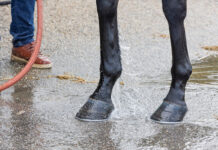
In this column, Dr. Lydia Gray answers your horse-health questions at horseillustrated.com/AskTheVet. Got a question for Dr. Gray? Send it to hc-editor@luminamedia.com and use subject line “Ask the Vet.”
Q: My horse and I live in New England, and we have a pretty low-key workout routine in the winter (not by choice!) I start working on building my horse’s fitness back up in the spring, and by summer we’re training five to six days each week and competing pretty regularly. We wind down late in the fall and then the cycle starts again. I don’t change his feed much seasonally, and I’m wondering if I should. Our turnout areas aren’t very productive, so he gets free choice hay year-round. Should I up his grain or add supplemental nutrition when we’re in the height of riding season?

A: First of all, your horse’s program seems very well structured! It sounds like you understand the importance of not letting horses completely down in the off-season as well as bringing them back into full work gradually.
Dr. Hilary Clayton’s Conditioning Sport Horses is a bit dated now–having originally been written in 1991–but it still provides a wonderful introduction to exercise physiology. Here’s a paragraph from Chapter 7: Conditioning Principles:
Preparation of a horse for any type of competition involves a combination of conditioning and schooling. Conditioning induces physiological and structural adaptations that maximize performance and maintain soundness; schooling develops neuromuscular coordination and mental discipline. The skillful trainer integrates conditioning drills with schooling exercises to produce a horse that is physically fit, mentally fresh, and fully prepared for the demands of competition.
You’re absolutely correct that part of fully preparing a horse for the demands of conditioning, schooling, and competition is proper nutrition. I encourage you to get your hands on a copy of the NRC’s Sixth Edition of Nutrient Requirements of Horses which includes tables of the minimum levels needed for key nutrients per age, weight, and workload. This resource even provides example weekly workloads of horses in light, moderate, heavy, and very heavy exercise categories. Some owners choose to use this data, work with an equine nutritionist, and analyze their horse’s hay, grain, and other feedstuffs to ensure that their horse’s diet is complete and balanced for his specific activities.
If you would like to take a simpler approach, perform regular weight tape readings and body condition scores (BCS) and record them in your horse’s journal. By measuring his weight and evaluating his body condition every two weeks or so throughout the year and documenting these numbers, you’ll be more likely to notice upward and downward trends and be able to act upon them quickly. You don’t say what breed of horse you have, his age, or what you do with him, but you also don’t indicate that he’s a hardkeeper or easykeeper, or that he loses weight during the busy summer or packs on the pounds during the lazy winter. If so, you’re lucky to have such a steady Eddy!
Free choice hay year-round is a great foundation for his diet. Next, make sure he has a source of salt and/or electrolytes that he is willing and able to take in (I say this because many horse owners only set out a salt block and most horses won’t lick enough to meet their sodium needs). Since hay rapidly loses Vitamins A and E as soon as it’s cut—and because depending on the source it probably doesn’t meet your horse’s mineral requirements—I recommend a multi-vitamin/mineral supplement to add back in key nutrients. If you feel like your horse could use a bit more muscle (or you had your hay analyzed and you KNOW it doesn’t contain adequate levels of protein) move up to a ration balancer, which includes amino acids as well as vitamins and minerals. If your horse needs calories to maintain his weight and energy level–especially during the competition season–your options are: adding whole or fortified grain, beet pulp, hay pellets or cubes, or fat.
Examples of whole grain are oats, corn, and barley, with oats strongly preferred for horses. If you feed a whole grain as a source of calories, your horse will still need the full multi-vitamin serving. Fortified grain refers to a commercial product in a bag that typically includes several kinds of whole grain along with a vitamin/mineral pellet so that your horse gets calories along with other nutrients. Now, this only works if the horse is fed the full amount of fortified grain recommended on the bag. So if Brand X says feed 6lbs a day to your 1200lb gelding in moderate work and you’re only giving 3lbs, he’ll still need a partial serving of a multi-vitamin. Moving on to other sources of calories, most horses love soaked beet pulp and hay pellets or cubes, gobbling them up along with any supplements or medications that may have been added to the mixture. Finally, fat is another excellent source of calories for horses, although your guy probably doesn’t need it.
Basically, it sounds like you’re doing everything right, just add weight measuring and body condition scoring to the list of parameters you routinely check, then adjust the calorie component of his diet accordingly to keep him at that ideal BCS of 5!





